|
Fiesta Fun
by Bob Brooke
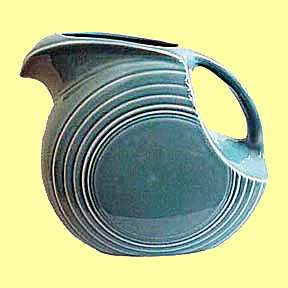 The
bright colors of Fiesta dinnerware brightened many a table up to the
mid-1970s. Most people associate its style and colors with the
1950s. But actually it appeared during the Great Depression in the
mid-1930s. Englishman, Frederick Hurten Rhead, designed the simple
Art Deco shapes while chief engineer Victor Albert Bleininger
fabricated the colorful signature glazes. Both worked for the Homer
Laughlin China Company of Newell, West Virginia. The
bright colors of Fiesta dinnerware brightened many a table up to the
mid-1970s. Most people associate its style and colors with the
1950s. But actually it appeared during the Great Depression in the
mid-1930s. Englishman, Frederick Hurten Rhead, designed the simple
Art Deco shapes while chief engineer Victor Albert Bleininger
fabricated the colorful signature glazes. Both worked for the Homer
Laughlin China Company of Newell, West Virginia.
Originally, the company offered 37 different affordable pieces,
ranging from candle holders and ashtrays to large serving dishes,
each in five bright colors: red-orange, yellow, green, cobalt blue,
and ivory. It added turquoise in 1939 for a total of six basic
colors.
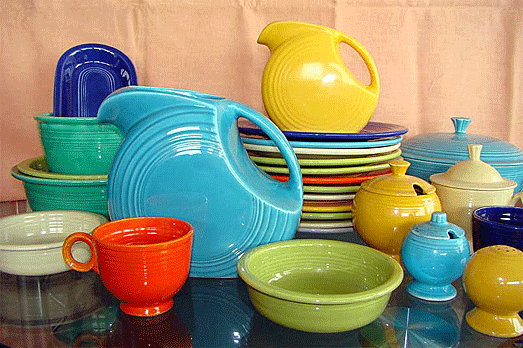
Homer Laughlin pioneered a whole new concept in dinnerware with Fiesta.
When the company first introduced the dinnerware at the annual Pottery
and Glass Exhibit held in Pittsburgh, Pennsylvania, in January 1936, its
line was the first widely mass-marketed, solid-color dinnerware in the
country. The forms and surfaces had an Art Deco influence. It was also
the first dinnerware that consumers could purchase by the piece instead
of in complete sets, as was the custom at the time. This allowed
customers to mix and match, perhaps choosing a different color for each
place setting, or have all their dinner plates one color, their cups and
saucers another, and so on. This concept became instantly popular with
the public, and soon Fiesta dinnerware became a runaway hit.
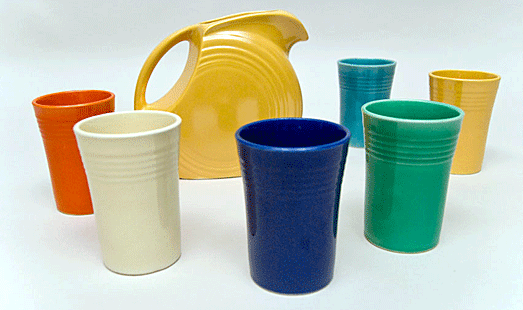
Fiesta was the first dinnerware that could be purchased by the piece
allowing customers to have a different color for each setting, or all
their dinner plates of one color, all their soup bowls another, and so
on. This concept of mix-‘n-match in solid color designs caught the
imagination of the public, and together with its crisp Art Deco style,
caused Fiesta ware to become widely popular.
People could not only design their own color schemes, but could also
build their collections one or two pieces at a time rather than
purchasing an entire dinner set—a boon for newlyweds. Although common
now, this was a radical departure from convention in 1936. Only full
dinner sets were available back then.
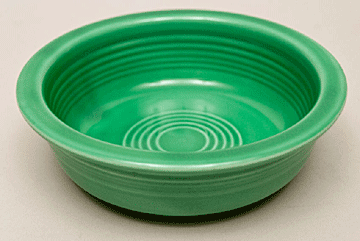 At
its introduction, Fiesta dinnerware consisted of the usual place
settings of dinner plates, salad plates, soup bowls, and cups and
saucers, plus occasional pieces such as candle holders in two designs, a
bud vase, and an ash tray. These came in five colors—red-orange, cobalt
blue, light green, deep golden yellow, and old ivory or yellowish cream.
By 1938, two years into production, the company added a sixth color,
robin’s egg blue. With the exception of the red-orange, discontinued
before 1944, this color assortment remained in production until
approximately 1950. At
its introduction, Fiesta dinnerware consisted of the usual place
settings of dinner plates, salad plates, soup bowls, and cups and
saucers, plus occasional pieces such as candle holders in two designs, a
bud vase, and an ash tray. These came in five colors—red-orange, cobalt
blue, light green, deep golden yellow, and old ivory or yellowish cream.
By 1938, two years into production, the company added a sixth color,
robin’s egg blue. With the exception of the red-orange, discontinued
before 1944, this color assortment remained in production until
approximately 1950.
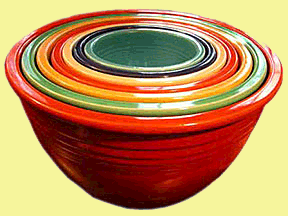 A
set of seven nested mixing bowls ranged in size from five to twelve
inches in diameter. The company also sold basic place settings for four,
six and eight persons. But the idea from the start was to create a line
of open-stock items from which the consumer could pick and choose based
on their personal preference. From its first introduction in 1936 and
for over a decade, Fiesta ware became a trendy fad. The dinnerware
became something of a status symbol for late 1930s and pre-war 1940s
middle-class households. A
set of seven nested mixing bowls ranged in size from five to twelve
inches in diameter. The company also sold basic place settings for four,
six and eight persons. But the idea from the start was to create a line
of open-stock items from which the consumer could pick and choose based
on their personal preference. From its first introduction in 1936 and
for over a decade, Fiesta ware became a trendy fad. The dinnerware
became something of a status symbol for late 1930s and pre-war 1940s
middle-class households.
The Homer Laughlin Company quickly added several additional items to
their line and eliminated several unusual items—a divided 12-inch plate,
a turquoise covered onion soup bowl, and the covers for its set of
mixing bowls. The Fiesta line eventually consisted of 64 different
items, including flower vases in three sizes, water tumblers, carafes,
teapots in two sizes, five-part relish trays, and large plates in 13-
and 15-inch diameters.
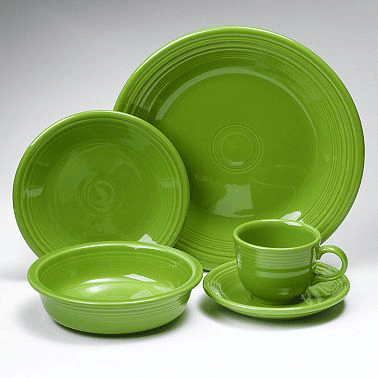 The
onset of World War II forced the company to reduce the number of items
in the Fiesta line as public demand declined and companies cut back
non-war related production. The
onset of World War II forced the company to reduce the number of items
in the Fiesta line as public demand declined and companies cut back
non-war related production.
Over the next four years, the company discontinued the more unusual
serving pieces, and by 1946, the line's variety of items had been
reduced by nearly a third. Overall sales of the more typical
place-setting pieces of Fiesta remained strong and reportedly peaked
around 1948.
The design of the original dinnerware pieces remained unchanged from
1936 to 1969.
The texture of the original glazes, and throughout the life of vintage
Fiesta, was semi-opaque. This is smooth and glossy, but without any
shining glare, rather more like an eggshell. The ware sometimes shows "
glaze curtains", areas of uneven glazing where a heavy application meets
a lighter one.
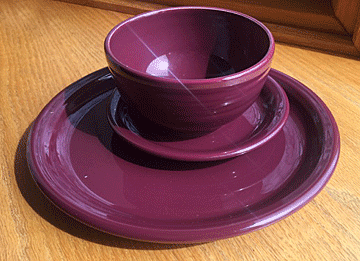 However,
the company did change its colored glazes to keep up with home
decorating color trends. It introduced four new colors—rose, gray, dark
green, and chartreuse, replacing the original blue, green, and ivory.
Yellow and turquoise continued in production. However,
the company did change its colored glazes to keep up with home
decorating color trends. It introduced four new colors—rose, gray, dark
green, and chartreuse, replacing the original blue, green, and ivory.
Yellow and turquoise continued in production.
By the end of the 1950s, sales again dropped, so the company reduced its
offering of items and changed the glaze colors once again. This time, it
introduced a medium green, to distinguish it from other green glazes
which the company had produced. This shade of green is in high demand by
collectors, and certain pieces in this color command extremely high
prices.
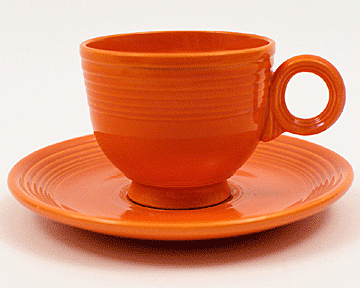 Homer
Laughlin removed the original red-orange color, the most expensive glaze
to produce, before 1944 because it contained uranium oxide which the
government needed to construct the atom bombs. Therefore, red pieces
also usually command a premium price in today’s collectible market. Homer
Laughlin removed the original red-orange color, the most expensive glaze
to produce, before 1944 because it contained uranium oxide which the
government needed to construct the atom bombs. Therefore, red pieces
also usually command a premium price in today’s collectible market.
By 1969, the company restyled the finials on covers, handles on cups,
bowl contours and shapes to give them a more contemporary style.
Although essentially the same Red glaze as had then been available since
1959, it was renamed Mango Red.
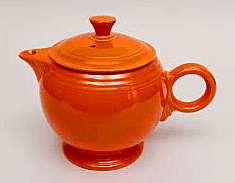 Fiesta
dinnerware became popular once again as baby boomers began establishing
their own homes. In the 1970s, Art Deco designs from the 1920s and 1930s
became popular once again. Not long after Homer Laughlin discontinued
the brightly colored dinnerware line in January 1973, collectors began
buying up what remained at garage sales and second-hand shops. Prices
for it hit the roof and by the mid-1980s, prices of Fiesta items reached
$100 for scarcer pieces. Fiesta
dinnerware became popular once again as baby boomers began establishing
their own homes. In the 1970s, Art Deco designs from the 1920s and 1930s
became popular once again. Not long after Homer Laughlin discontinued
the brightly colored dinnerware line in January 1973, collectors began
buying up what remained at garage sales and second-hand shops. Prices
for it hit the roof and by the mid-1980s, prices of Fiesta items reached
$100 for scarcer pieces.
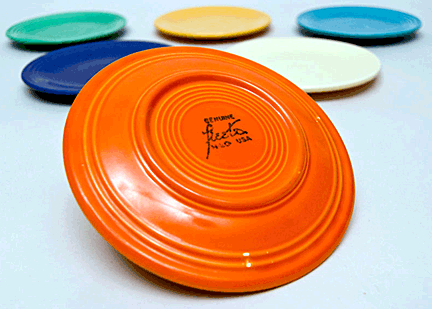
Generally, serving pieces such as casserole dishes, carafes, teapots,
and water pitchers almost always have higher values than normal place
setting pieces. As mentioned earlier, certain colors are also priced
higher, no matter what the piece.
<
Back to More Antique Spotlights
Next Article > |
